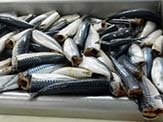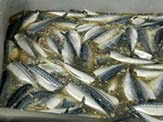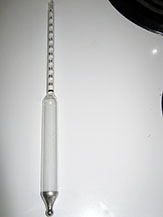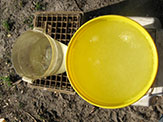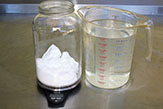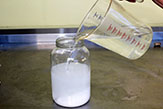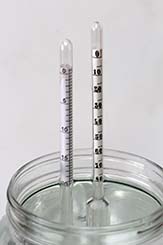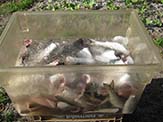Meats and Sausages
Curing Fish
Prior to smoking, fish are either dry salted or brined. They may be lightly or heavily brined depending upon the type of product to be prepared. Lightly salted fish should be smoked immediately since the brining merely imparts a desirable flavor and firms the flesh. The salt content of the flesh of hot smoked fish should be about 1.8-2%, which corresponds to the salt content in most smoked sausages. Heavy brining is used in the mild curing of salmon and for preserving fish until smoking can be applied. Such a fish must be soaked prior to smoking to remove most of the salt.
Origins of Fish Curing
Fish salting was practiced for thousands of years. England and Norway derived a large portion of income by selling cured herring, cod and salmon to Southern European countries. Fish was traded for olive oil, wine, and dry fruit, products that would not grow in cold climates. The discovery of America in 1492 by Christopher Columbus has given a way to trade. Spain was busy conquering islands and countries in South America, but England followed the shortest route and started to establish new settlements on the Northern Atlantic coast, first in Newfoundland, then in New England.
The early colonists would not have been able to survive without protein-rich food like salted cod or smoked herring as the climate was harsh and the soil was poor. But the fish was plentiful, and cured fish became their main source of income. Salt cod and salmon smoked herring and halibut, and pickled sturgeon were soon exported to Europe. The cold climate was perfect for transporting salt fish to Europe, according to records, in 1580, more than 300 ships from Europe were engaged in salting cod in this area. This trade in salt fish stimulated further trade and growth in other industries. There was plenty of timber, and local manufacturing started to flourish. This led to more trade and more shipping lines.
Curing fish was the main preservation method until Nicholas Appert invented the canning process in 1810. This was followed by the discovery of electricity, and from 1900 on, canning and refrigeration became popular preservation methods. These methods were more economical and produced food of higher quality and less spoilage. Changing food habits has also contributed to a decline in curing methods. European immigrants brought meat curing and smoking technology to America, but their children developed different food habits. Most foods today are prepared by either canning or drying or are kept under refrigeration. Keep in mind that every quality ham, sausage, or smoked fish is always mildly cured, regardless of whether it is produced in a factory or at home. Commercial producers may use specialized machines to make the process faster, but a hobbyist can produce even better products at home. The curing process, however, remains the same as it has been practiced for centuries.
England was always known and respected for the quality of their smoked fish. Torry Research Station, a division of the Department of Scientific and Industrial Research, designed the Torry Kiln, a mechanical fish smoking kiln, in 1939, which has been widely adopted by the fish-smoking industry. They have also printed “Fish Smoking”-A Torry Kiln Operator’s Handbook, an excellent manual about smoking fish. Detailed instructions were given for the preparation of the typical smoke-cured products. In all the examples 80 degree brine was used and this brine strength has become very popular.
Curing by Salting Alone
Man was able to catch large number of fish, regardless of their size, the problem was how to preserve the catch. Salting fish was one of the first preservation methods, however, the fish had to be desalted for a few days before cooking started. Salting and drying fish is practiced today only in remote areas without access to electricity. Light salting and brines are used for fish that would be immediately smoked. After brining, the fish is briefly rinsed and submitted to drying. The salt concentration is usually below 2%. The majority of hot smoked fish falls in this category. Heavy salting and brines are used to prepare fish for cold smoking or to preserve the fish until the smoking process can be applied. The salt concentration reaches 8-10%. Preserved fish is kept in closed barrels until processing time. Such heavily cured fish is soaked in cold water to bring the salt content down. Cold running water will be most effective, standing water will need a few changes. Then the fish can be cooked or cold smoked.
Brining (Wet Curing)
All fish for hot smoking are brined to give them flavor. The recommended brine strength for most products is 80°; a stronger brine reduces the brining time but has the disadvantage that, after the fish is dried, the salt crystallizes on the surface of the skin in unattractive white patches. Salt is absorbed more uniformly by fish in brine weaker than 80°, but residence time is longer; an 80° brine is a practical compromise. After brining, whole fish are hung, for example, on tenters or speats depending on the product, and arranged in a kiln so that either the backs or the bellies, not the sides, of the fish face the smoke flow. Fillets and small products like shellfish meats are laid on wire mesh trays.
Brining provides the following advantages:
- Improves the flavor and looks of the fish.
- Improves texture by making flesh much stronger which is important if the fish is hung.
- Prevents growth of bacteria.
- Develops skin gloss (best with 70-80º brine).
Brine Strength
There is no one universal brine that may be applied to all fish. The composition of the brine depends on the fish type, the thickness of the fillet or the size of the fish, and the fattiness of the fish. If the flesh is not very thick, most of the salt enters within the first 3 or 4 minutes. Salt is absorbed more uniformly by weaker brines, but the brining time is longer. The advantage of a stronger brine is that it is more effective at inhibiting bacteria growth.
Typical brines:
| Product | Brine strength in º Salinometer |
| Poultry | 21 |
| Pork Loin | 30 |
| Pork butts, hams | 40-50 |
| Hot Smoked Fish | 70-80 |
| Cold Smoked Fish | 80-90 |
| The strength of seawater is 14º. | |
Making one gallon brine using cups of salt:
| Salt (cups) | Water (1 gallon) | Brine strength in º Salinometer |
| 1 | 1 | 27 |
| 2 | 1 | 45 |
| 3 | 1 | 72 |
| 3.5 | 1 | 80 |
| 4 | 1 | 90 |
The recommended brine for most fish is 70-80 degrees; a brine stronger than 90° may leave salt crystal deposits on the skin of the fish, which leaves unattractive permanent white patches. Heavy brine can be used to preserve the fish until the smoking process can be applied. After a successful catch, you may not have sufficient time to smoke all the fish on the same day. Clean and gut the fish, and place them in a heavy brine - this will buy you time. Then, a few days later, when you have more time, the fish can be desalted (soaked) and smoked. Fish can be heavily or lightly brined, depending on the required product. A large fish and fat fish absorb salt slowly. Stronger brines require a shorter time of brining. Lightly salted fish can be smoked immediately since the brining was used merely to firm the flesh. Brine becomes weaker with use, however, this is of lesser importance in home production. Water on the surface of the fish dilutes the brine, and the fish absorbs some salt. Commercial plant maintains the strength of the brine by adding more salt. As minuscule pieces of fish, gut, scales, and blood start to contaminate the brine, the brine should be changed daily. Let’s make something absolutely clear - smoked fish needs salt. This can be accomplished by sprinkling fish with salt or immersing fish in salty brine. All other ingredients may influence the flavor of smoked fish, but only a little. Those ingredients may as well be added to the fish during a meal. In addition, you can serve fish with one of many classic sauces, which will influence the flavor of the fish much more than adding pepper, sugar, or lime to brine. Those ingredients will release their flavor better when brining times are longer, but you have to decrease the strength of the brine, or the fish will end up too salty.
One gallon of brine is sufficient for 4-5 pounds of fish. Other ingredients, like sugar and spices, should be added to the solution after the correct brine strength has been established. Fish pieces should be completely immersed in brine and covered with a weight plate. The temperature of the strong brine should not exceed 60° F (15.5° C). If the brining time exceeds 4 hours, the solution must be placed in a refrigerator (38° F), or ice should be added to the brine. Adding ice will change the strength of the brine, so a better solution is to add re-usable ice packs. Keep in mind that brine loses its strength in time as salt penetrates the meat, leaving behind a weaker solution. When brining times are long, the solution’s strength should be periodically checked with a brine tester and readjusted accordingly.
Most professional literature and practices of commercial plants, Torry Kiln research papers included, choose 80º brine as the overall choice. A 70-80° brine can be employed for all the common types of fish. By placing fish in a strong brine, we are performing an all-out attack on the bacteria, preventing them from growing. Salt penetrates the flesh of fish very rapidly, and the brining times are relatively short. Fish brined in 90-100° brine will lose around 3% of its weight. We will obtain more uniform salt penetration if the brining times are longer, but that will require a 30-40 degree solution. In such a brine, fish may be left overnight but will pick up about 2-3% of water, which needs to be evaporated during smoking, making the process longer.
Making Brine
There isn’t a universal brine, and every book and recipe provides customized instructions. Many recipes call for mixing salt with water until the egg or potato starts to float. We have tried that, and the results were misleading. Does anybody think that a fish processing plant will test the brine with an egg or potato? First, it makes no sense at all to talk about curing time if we don’t specify the strength of a brine. We can mix ½ cup salt with one quart of water, or we can add 5 cups salt into one gallon of water, and it is obvious that curing times will be different, though both brines will do the job. To prepare your own brine in a professional way, you need two things:
1. Buy a brine tester. They are so cheap that there is no excuse for not having one. The salinometer consists of a float with a stem attached, marked in degrees. The instrument will float at its highest level in a saturated brine and will read 100 degrees (26.4 % salt solution). This is known as a fully saturated brine at 60° F (15.8° C). Beyond this point, no more salt can be dissolved in water; the salt will settle at the bottom of the container. In weaker brines, the stem will float at lower levels, and the reading will be lower. With no salt present, the reading will be 0. To make brine, put some water into a suitable container, add some salt, insert a brine tester, and read the scale. Want a stronger solution? Add more salt. Need a weaker brine? Add more water, it is that simple.
Note Keep in mind that a salinometer’s scale measures the density of a solution containing salt and water. Once you add other ingredients, they will alter the density of the solution, affecting the salinometer reading, while the salinity of the brine will actually be the same.
The brine tables are tested at 60° F (15.8° C). For other brine temperatures, the observed salinometer readings must be converted before using them. Add one salinometer degree for each 10 degrees above 60° F and subtract one degree for each 10 degrees below 60° F.
2. Making Brine Using Tables - the fastest way for making brine.
- Choose the strength of the brine.
- Prepare one gallon of water.
- Weigh the amount of needed salt as listed in the table.
- Add salt to water, mix, and wait to clarify.
| Brine at 60° F (15.8° C) | Salt (in pounds) to 1 US gal of water | % salt by weight |
| 10 | 0.22 | 2.64 |
| 20 | 0.46 | 5.28 |
| 30 | 0.71 | 7.91 |
| 40 | 0.98 | 10.55 |
| 50 | 1.26 | 13.19 |
| 60 | 1.56 | 15.83 |
| 70 | 1.88 | 18.47 |
| 80 | 2.23 | 21.11 |
| 90 | 2.59 | 23.75 |
| 100 | 2.98 | 26.39 |
To see more detailed a degree by degree tables go to Complete Brine Tables
To make 80° brine, we need to add 2.23 pounds of salt to 1 gallon of water. If you need a smaller quantity of 80° brine, add 1.1 lb salt to half a gallon of water. The procedure is simple, fast, and accurate. The tables cover brine from 0 - 100° in one-degree intervals. There are separate tables for UK gallons (4.54 liter), which can be obtained on the internet.
It does not matter whether US or UK tables are used, as the salt-to-water ratios remain the same, for example:
| US gallon (3.8 liter) | UK Imperial gallon (4.54 liter) | |
| Salt per gallon | 2.22 lb | 2.67 lb |
| % salt by weight | 21% | 21% |
| Brine Strength | 80° | 80° |
Because UK gallon is bigger, more salt is added, but the percent of salt by weight is the same in UK or US brine of equivalent strength.
Making Small Amounts of Brine
| Brine Strength | Salt (in grams) added to 1 quart of water | Salt (in grams) added to 1 liter of water | % salt by weight |
| 4° | 10 | 11 | 1.0 |
| 10° | 24 | 26 | 2.6 |
| 20° | 50 | 55 | 5.2 |
| 30° | 79 (1/4 cup) | 86 | 8.0 |
| 40° | 105 | 118 | 10.5 |
| 50° | 145 (1/2 cup) | 151 | 13.2 |
| 60° | 178 | 188 | 15.8 |
| 70° | 214 (3/4 cup) | 226 | 18.4 |
| 80° | 248 | 267 | 21.0 |
| 90° | 294 (1 cup) | 311 | 23.7 |
| 100° | 339 | 358 | 26.3 |
| 1 liter of water = 1000 g, 1 qt of water = 946 g, 1 cup salt = 292 g 1 Tablespoon salt = 18 g, 1 teaspoon salt = 6 g, 1 oz = 28.35 g 1 Tbsp = 3 tsp. 1 US gallon = 3.8 liters = 3.8 kilograms = 8.33 lbs. Seawater contains approximately 3.695% salt, which corresponds to 14 degrees salometer (°SAL). |
|||
Keep in mind that the volume of the brine that was made by combining one gallon of water with 2.2 lbs salt (80º brine) will be larger than one gallon, so use the appropriate container. The main advantage of making your own brine is that you have total control, and there is no guessing involved.
Baumé Scale
You may come across a popular European Baumé degrees brine scale that is based on the specific gravity of the brine measured with a hydrometer, which is a specially designed float similar to a brine tester. After taking a reading, one can refer to the table and look up the % NaCl (salt) by weight. One Baumé degree corresponds to 10 g of salt in 1 liter of water. The table below compares the SAL brine strength degrees with the Baumé scale.
| Specific Gravity | % Salt by Weight | Baumé Degrees | US Salometer Degrees (º SAL) |
| 1.007 | 1 | 1.0 | 4 |
| 1.014 | 2 | 2.0 | 8 |
| 1.022 | 3 | 3.1 | 12 |
| 1.029 | 4 | 4.1 | 15 |
| 1.037 | 5 | 5.2 | 19 |
| 1.044 | 6 | 6.1 | 25 |
| 1.051 | 7 | 7.0 | 27 |
| 1.058 | 8 | 7.9 | 30 |
| 1.066 | 9 | 8.9 | 34 |
| 1.073 | 10 | 9.8 | 37 |
| 1.081 | 11 | 10.9 | 41 |
| 1.089 | 12 | 11.9 | 46 |
| 1.096 | 13 | 12.7 | 50 |
| 1.104 | 14 | 13.7 | 54 |
| 1.112 | 15 | 14.6 | 57 |
| 1.119 | 16 | 15.4 | 61 |
| 1.127 | 17 | 16.3 | 65 |
| 1.135 | 18 | 17.2 | 69 |
| 1.143 | 19 | 18.1 | 72 |
| 1.151 | 20 | 19.0 | 76 |
| 1.159 | 21 | 19.9 | 80 |
| 1.168 | 22 | 20.9 | 84 |
| 1.176 | 23 | 21.7 | 88 |
| 1.184 | 24 | 22.5 | 92 |
| 1.192 | 25 | 23.4 | 95 |
| 1.201 | 26 | 24.3 | 99 |
- Left - Baume hygrometer (20º Be)
- Right - Salinometer (80º SAL).
- The readings confirm data in the table.
Speed of Curing
The speed of curing depends on whether we process whole fish, whole gutted fish, fish steaks, or fillets. Fillets with the skin on will cure slower because the skin acts as a barrier that inhibits any flow of solution, moisture, or even smoke. <The skin with scales will cure even slower. At higher temperatures, the curing develops faster. Fish will cure faster when it receives more salt, whether by dry salting or by being immersed in a heavy brine. Fat fish cures slower than the lean ones, the reason being that fat inhibits diffusion of salt. Salt dissolves easily in water but not in fat. Lean flesh contains around 80% of water, but fat contains only 10-15% of water. Generally speaking, the brining time depends on the size of the fish and the salt concentration of the brine.
Salt penetrates fish easier in places that are open or cut than through the skin. It is hard to derive time for fish fillets, fish with the skin on, and little fish or pieces of fish. The fish fillet will be oversalted if immersed for the same time in the same brine as a large fish. When brining fish of different sizes, it is advisable to use separate containers and classify fish according to species and size. When using a single container, place small pieces on top so they can be removed earlier. Salt penetrates the flesh of the fish within minutes, and brining times are much shorter than those for red meats.
| "Rule of thumb" brining times for whole fish | |
| Brine strength | Brining time |
| 30º | 10-12 hours |
| 50º | 3-4 hours |
| 80º | 1-2 hours |
- Brining times (80º brine) for cold smoking:
- ½” fillets - ½ hr
- 1” fillets - 1 hr
- 1½” fillets - 2 hrs
- Brining times (80º brine) for hot smoking:
- ½” fillets - 15 min
- 1” fillets - 30 min
- 1½” fillets - 1 hr
- Small whole fish - 1-3 hours
A medium-sized whole herring, which is a fat fish, should remain in 80 degrees brine for about 4 hours. Herring fillets need to be submerged in the same brine for only 20-30 minutes. For short times, the heavy brine can be kept below 60º F (15.8º C). For longer times, the brine should be kept in a cooler. Fat fish such as salmon, mackerel, or herring should not be exposed to the air when cured. Otherwise, they may develop brownish spots on the exposed areas, which contributes to rancidity. This is known as “rusting.” Keep the fish fully covered with salt or submerged in brine. Commercial producers test brine for microbiological spoilage and can reuse it; however, in home applications, the brine should be changed daily. Brining and smoking fish is a lot of trial and error and record-keeping. Notes should be made for future reference.
A typical 80 degrees brine:
- 1 gallon water
- 2.25 lbs salt (4 cups)
- 1 lb brown sugar
- 2 Tbs Cure #1
- 1/3 cup lemon juice
- 1 Tbs garlic powder
- 1 Tbs onion powder
- 1 Tbs allspice powder
- 1 Tbs white pepper
What’s Better Dry Salt or Brine?
It is harder to get consistent results with dry salting as the fish come in different sizes, weights, and shapes. The brine, however, will find a way to enter every little opening. Brined fish will acquire salt and flavorings in all areas. If you catch one or two fish, sprinkling with salt may be more practical. It is faster to sprinkle fish with a dry mix and start smoking. It is a question of economics as less space and equipment is required. The processing time is shorter as fish does not need to be dried before the smoke is applied. In addition, a lot of salt will be wasted when brine is discarded. There is less salt waste when sprinkling fish with a dry mix. However, if you process 50 fish, then it becomes a little commercial venture, so brining is a better solution. A correct strength brine can be made a day earlier and may be kept in the refrigerator until needed. The advantage of using brine is that once the strength of the brine has been chosen, the product will always be consistent as long as the processing time takes into account the size of the fish. Fat fish should be fully submerged, as air contributes to rancidity.
Smaller establishments, such as fish restaurants or take-out stores, are very busy and don’t have enough storage space to keep fish in tanks. An additional employee might be needed to cope with those additional chores. Brining requires time. The brined fish is wet; it needs to drain and dry out before the smoke can be applied. To save space and time, they cure fish with a dry mix. However, smoked fish that is brined develops a beautiful shine, which is not present when the dry mix is used.
Dry Mixes
Fat fish is often cured with a mixture of salt, sugar, and spices. First, the salt is mixed with herbs, spices, and flavorings of choice; then, the mixture is rubbed gently into the fish. Into the belly, and more on the skin, which should be devoid of scales.
General formula for creating your own mix:
- Salt, 10-14 g
- Sugar, 3-6 g
- 1.5 g spice mix (pepper, hot pepper, cloves, cinnamon, ginger, nutmeg, mace, bay leaf, mint, hops, etc).
- The spices should be finely ground. Crush the hops and bay leaves.
Some dry mix combinations:
| Ingredients in grams | |||
| Dry Mix | Mix 1 | Mix 2 | Mix 3 |
| Salt | 70 | 50 | 75 |
| Sugar | 15 | 10 | 20 |
| Allspice | 2.5 | 5 | 2.5 |
| Black pepper | 1.0 | 5 | 2.5 |
| Red pepper | 1.5 | 0.8 | 0.5 |
| Cloves | 0.8 | 0.8 | 1.5 |
| Ginger | 0.8 | - | 1.0 |
| Coriander | 0.5 | - | - |
| Nutmeg | 0.5 | 0.8 | - |
| Mace | 0.2 | - | - |
| Cinnamon | - | - | 0.5 |
| Hops, crushed | - | - | 1.0 |
| Bay leaf, crushed | - | - | 1.0 |
The fish is laid down in a container for:
- Small fish, less than a pound - 4 hours.
- Large fish- 8 hours or overnight.
There are many ready-to-apply dry mixes that can be used for general cooking or smoking fish. Creole Seasoning is an excellent dry mix for smoking mullet made by Zatarain’s, New Orleans, LA.
Applying Dry Mix
Mix salt with spices of your choice. Rub the mixture all around, inside of the belly included; apply more force and mixture into the skin as the skin slows salt penetration. The rate of salt penetration is 20% faster in dry-salted fish than in brine. The skin creates obstacles to salt penetration, so this is why the fish skin (not the flesh) is often scorched with a knife. Fillets are very delicate, so just sprinkle dry mix on top. Lay the fish flat in a container and place in refrigerator. Rinse the fish briefly with tap water and proceed to smoking.
Note: dry salting fillets will result in drawing out the mixture of water, blood, and proteins to the surface. If the split fish or fillets are lying flat on screens, little liquid paddles will form, which will become white curd during smoking and cooking. This is a smaller problem in fish that are secured by hanging, as this protein solution will drip down.
- Small fish
- 3/4-1 lb, 3 hours salting time
- Fillets
- 1/2" fillets - 10 min
- 1" fillets - 25 min
- 1-1/2" fillets - 45 min
More About Salt
For brining purposes, both table salt and kosher salt will work equally well in terms of providing the desired effects, though kosher salt, particularly Diamond® Crystal kosher salt, dissolves more readily. What is important to remember is that kosher salts are less dense than ordinary table salts and measure quite differently from a volume standpoint. Kosher salt has larger crystals and is bulkier. For example, a given weight of Diamond® Crystal takes up nearly twice the volume of the same weight of table salt. Non-iodized salt should be used; canning rock salt is a good choice.
| Table Salt | 1 cup | 292 g (10.3 oz) |
| Morton® Kosher Salt | 1-1/3 to 1-1/2 cup | 218 g (7.7 oz) |
| Diamond® Crystal Kosher Salt | 2 cups | 142 g (5 oz) |
As you can see, it is always advisable to weigh out your salt.
Adding Spices to Brine
For an extra flavor, spices can be added; however, add them to weak brines only. Strong brines, 70-90º, do not leave enough time for the spices to bring any significant effect. About 1 tablespoon of herbs and spices can be added to one gallon of brine. Use ingredients that you like most; after all, you will eat the fish. Some of the popular seasonings are pepper, parsley, dill, capers, mustard seeds, rosemary, juniper, onion, cilantro, bay leaf, celery leaves, sugar, vinegar, and lemon juice. You can try commercially produced seasonings, which are sold in stores. After brining, briefly wash fish to eliminate excess salt and any traces of blood. Drain the fish, place them on screens or hang them and let dry. Then, smoke the fish.
Brine Marinades
Sugar, herbs, and spices may be added to the brine to produce original flavor.To saturate the fish with customized flavors, the fish has to remain in brine for a longer period of time, preferably overnight. Heavy brine such as 80º is not suitable, as the fish will be over-salted. A very lightly salted brine is needed, which may as well be called the brine marinade. Keep in mind that such a weak solution cannot be used in fish that will be cold smoked.
- Four degrees brine is a good all-around salt solution that needs only herbs and flavorings to become the marinade.
- 4° brine - add 10 g (1-1/2 tsp) salt to 1 quart of water.
- About one tablespoon of flavor-inducing ingredients are added to two gallons of 4º brine.
- Popular ingredients are dill, parsley, sage, thyme, capers, basil, rosemary, juniper berries, mustard seeds, garlic, ginger, onion, peppers, sugar, lemon juice, soy sauce, Worcestershire sauce, and vinegar.
The marinade should have the dominant flavor; this would be the herb or spice that you like most. Such an herb can be inserted into the fish the moment the fish has been gutted and washed in order to impart its flavor to the fish. Then, the fish should be fully immersed in the marinade overnight. The fish will not be over salted since below 50° F (10° C), the rate of salt uptake is reduced.
Brining/Marinating Fish
If you decide to use a strong brine, the whole process of smoking fish can be accomplished in 3-4 hours. You can, however, place fish in a weak brine, leave them overnight (10-12 hours) in the refrigerator, and start smoking the next day. Chicken is marinated the same way, although fish brine is weaker. It is recommended to start with a weak brine and keep notes for reference. There is not much we can do to over salted fish.
Curing/marinating times for small fish and fillets
| Fish | Brine | Time |
| Small fish | 4º | 10-12 hrs |
| Small fish | 10º | 2 hours |
| Fillets, 1/2 - 1" | 10º | 30-45 min |
Brine temperature should be kept at about 10° C; below this temperature, the rate of salt uptake is reduced. You can speed up the process even further by using 80-90º commercial strength brine.

